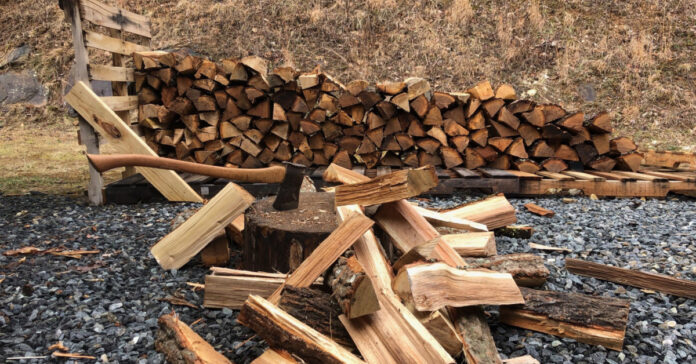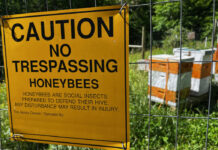For the last few days, our garage has smelled like beeswax, which is a nice, mellow smell. It reminds me of spring.
I started building beehive frames, and I am using plastic foundation that has a heavy coat of wax on it. When I pop them into the frames, tiny bits of wax along the bottom of the frame get squeezed off. I’m pretty sure that’s where the smell originated.
I should have enough large frames for all my newly assembled hive boxes, but I need to take an inventory to be sure. In addition to the hive bodies, I have four bottom boards and three lids, so I need to build at least one more lid. I’ve already got extra feeders and queen excluders, so with only a bit of work, I’ll be ready to add up to four hives this spring.
Building ten supers will be my next project, followed by constructing frames for the supers. Last year, I had to build supers in the middle of the summer. By building these ten, I hope to have enough to stack two or three on each hive.
I still have some unused black plastic frames, but another beekeeper gave me five eight-frame medium hive bodies, so I will use the plastic supers in that hive. I’ll need to make a hive bottom and top to fit this smaller equipment. That will have to wait until the weather is nice enough to roll the table saw out of the garage, so I have enough room to use it.
Inflation on the Homestead
I looked into getting one of those pre-built storage buildings. Nothing huge, just a 10’ x 12’ or an 8’ x 16’. Prices are almost double what they were pre-COVID. Besides the price increases on chicken feed, beehive components, pet food, food, and fuel, you can add pre-built sheds. I’m betting they don’t look at the price of these sheds when they calculate the CPI.
The same company also installs fences. While we were talking about price increases, the owner said most of his fencing has been going up 25 percent per year since the start of COVID. He told me his most expensive fence is vinyl because it’s derived from crude oil. So we can now thank Joe Biden and his anti-fossil fuel policies for rising fencing prices.
Hourly wages are still relatively low around here, especially compared to the cities. Most retail and food service jobs pay around $13 an hour. Of course, if you are a heavy equipment operator or a welder, that number shoots up pretty fast. This is not a prosperous area, and with those wages and the rising rate of inflation, I see tough times ahead for many of our neighbors. No wonder they plant so many potatoes and shoot so many deer.
Firewood Stacking
Lately, we’ve been doing a lot of stacking. Not silver stacking, unfortunately, but firewood stacking. The stacking had to be spread over time because our last delivery was filled with larger logs that required splitting. I think maybe my supplier is rushing through orders because of high demand.
This load had logs ranging in length from 12 inches to 21, with most in the 15 to 18-inch length. I started splitting the shorter logs, which we use in the upstairs fireplace insert. That insert is not very large, so the shorter logs work best in it. Seeing the size of some of the 18 and 20-inch logs, I decided I’d better split some of them as well. The big logs will fit inside our woodstove, but when they get heavy, they are difficult for my wife to handle, and she loads the stove every morning and whenever I am out. Also, splitting them into smaller pieces will help the logs dry faster.
The weather has slowed the splitting because we’ve been having more days with rain or snow than days with sun. One day the chicken run is frozen solid. The next it is a soupy mess. I’d say it snowed more frequently this year than last, but I think our cumulative snow total was higher last year.
Splitting Wood
I can split wood with an axe or maul for only an hour without over-stressing my back, so I worked through it in stages. If I split wood for an hour, I feel fine the next day. If I split wood for two hours, my back hurts for several days. It makes walking uphill painful too, and that’s not something you want when you live on the side of a mountain. My hope is the splitting will strengthen it, as long as I don’t overdo it.
The last two wood deliveries have been an excellent mix of hardwood, mostly oak, hickory, locust, and a few logs that have a yellow center, or heart wood. I think the latter may be tulip poplar. These logs are lighter than the oak and are easy to split. The red oak has stringers and two pieces will sometimes cling together like they are on bungee cords even after they have split apart. The lighter wood flies apart with just a light bop from the axe. Assuming it is poplar, it will burn fast and hot, but it won’t last long. This lighter wood makes great kindling, is good to get the stove heated for cooking, but it’s not what you want for an over-night fire.
Running out of Wood
I am more than halfway through the wood I purchased to burn this year. Once again, it looks like I may have less than I need, even though I had more on hand than the year prior. At the rate we are burning, I expect I have enough to last through February, but not very far into March. I’ll have to burn the oak I split last year over Memorial Day Weekend. I had hoped to hold off burning it until next year, but may need it next month. The tree had been dead a while before I cut and split it, and it looks and feels pretty dry. It should burn fine.
Wet or green wood is not good for burning. Not only does it smolder and steam, putting out less heat than seasoned wood, but burning green wood contributes to creosote buildup in the stove pipe and chimney. Always let your wood age and season, if possible. The wood we are getting delivered and splitting now will be burned in the fourth quarter when temperatures drop. That will give it at least eight months to dry.
The other day when the outdoor temperatures reached the 50s, we let the fire die out. It took about 24 hours to drop from 72 degrees to 63 in the basement. The next morning, my wife relit it. Why live in a chilly house if you don’t have to?
On warmer days, I think we would might better off lighting the fire at night, burning it for eight or ten hours and then not restocking the stove the next morning. Then we can repeat the cycle. We often do this on sunny days in October. That would save firewood.
Limited Storage Space
One challenge we face is where to stack our firewood. We don’t have a large amount of flat space. A good portion of it has been claimed by the garden. If I want to have enough firewood on hand to last through the next winter with some extra to give me some breathing room, I’ll need to make my woodpiles either longer, wider, or taller.
I have already added a pallet to one of the storage locations that was recently emptied. (I put all my firewood on pallets to keep it off the ground to help the wood dry and prevent rot.) Forty to 45 cubic feet of wood fit on each pallet, which is about a face cord of firewood. I may add a second pallet.
We also store firewood on the lower level, accessible through the garage door. I think I can double the number of pallets I am using there. Adding four pallets with two rows across of firewood piled close to five feet high will increase our firewood storage by about a third.
Firewood and Fallout
With the threat of nuclear war lurking in the background, I have picked out a corner of the basement where we will shelter to protect ourselves from fallout, if necessary. The basement walls are concrete, which is an excellent radiation barrier, and the above-ground portion has a rock veneer, which will also help. I have fourteen bags of dirt I will pile on top of the floor above us. Each one is 1.5 cubic feet. Seven inches of dirt will reduce the radiation that penetrates it by 75 percent.
Assuming that we have advanced warning of oncoming fallout, I plan to pile as many rows of firewood as I can around our home’s exterior walls to act as further a barricade. I know wood is not as good as absorbing gamma radiation as dirt or concrete, but it’s here and it’s handy. It’s also going to be better than nothing.
Remember, when it comes to radiation, the more time since the explosion and the greater distance you are from the source, the lower your exposure will be. Fallout, however, may bring a radiation source to you. In that case, surrounding yourself with a heavy dense material is your best defense. Lead is what laboratory professionals use, but cement and dirt work well for the rest of us. That’s why underground shelters are recommended. Our basement is as close to being underground as we can get.
If you are at all worried about fallout, I recommend this article on how to protect yourself from fallout and searching the web for a PDF copy of Nuclear War Survival Skills by Cresson H. Kearny.








